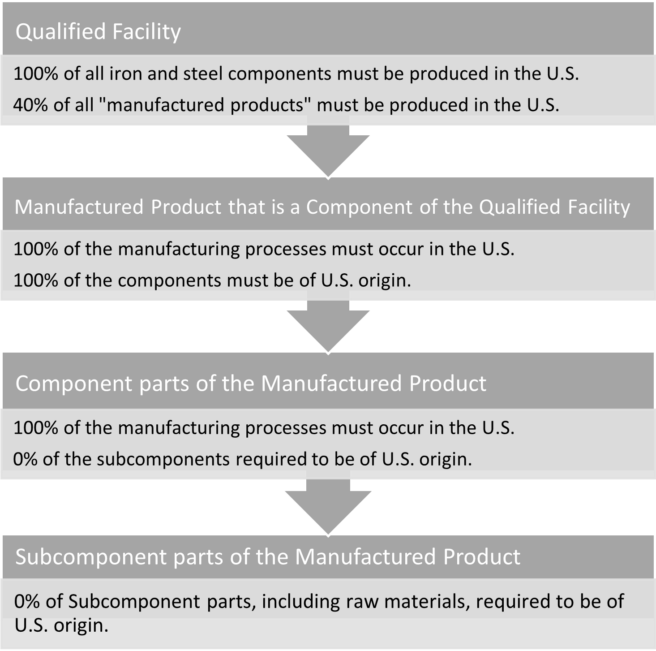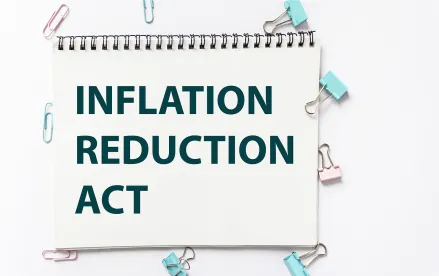For years, domestic content requirements have been a point of pain and frustration for government contractors. Historically, these regimes typically come in the form of the proverbial stick – that is, provide products and/or services that meet these country of origin requirements, or risk severe consequences (the billions in False Claims Act Trade Agreements Act settlements speak for themselves). But through the Inflation Reduction Act of 2022, Congress has taken a unique approach by authorizing the Department of Treasury to use country of origin as a carrot – offering certain energy facilities bonus tax credits for meeting specified “domestic content” requirements. To create this new carrot, Congress relied heavily on the Government’s prior experience with domestic content regimes – pulling predominantly from the Federal Transit Authority’s (“FTA”) “Buy America” regulations, but with a Buy American Act twist. In doing so, Congress has left the renewable energy industry with more questions than answers on the applicability of the bonus tax credit to their facilities.
Treasury is in the process of releasing guidance to assist energy facilities in navigating these domestic content waters, but there has been no word from Treasury on when we can expect this guidance – and there is no guarantee the guidance will answer all questions. In the meantime, and in the absence of any direct guidance, energy facilities must instead look to traditional government contractors for any guidance in this regard. We take a look below at how the Government might perform a domestic content bonus credit analysis based on our experience with other country of origin regulations, and identify key unanswered questions in anticipation of the Treasury guidance.
Inflation Reduction Act Overview
Under the Inflation Reduction Act (“IRA”), certain energy projects that satisfy the IRA domestic content requirements may qualify for bonus points on their Production Tax Credit (“PTC”) or Investment Tax Credit (“ITC”). Qualifying for the bonus credit is easy – simply meet the domestic content requirements of the IRA, and your PTC/ITC is increased by 2-10%. Depending on the project at issue, these bonus points can amount to tens of millions of dollars in additional tax credits. But, of course, nothing in life is that easy. Determining whether your project actually will meet the domestic content requirements of the IRA is where things gets dicey.
The IRA, inter alia, revised Sections 45 and 48 of the IRS Code to incorporate these domestic content preferences. Specifically, Section 45 provides that, with respect to any “qualified facility,” a 10% bonus credit can be earned if the taxpayer can certify “that any steel, iron, or manufactured product that is a component of such facility (upon completion of construction), was produced in the United States (as determined under section 661 of title 49, Code of Federal Regulations).” 26 U.S.C. § 45(b)(9)(B)(i). Fear not – if you had to read that quote four times to get the basics, you are not alone.
Essentially, the IRA domestic content requirements are broken down into two familiar categories: (1) iron/steel products and (2) manufactured products.
For iron and steel products, taxpayers must look to the FTA Buy America regulations (specifically, 49 C.F.R. § 661.5) to determine whether the iron/steel products are “produced in the United States,” as will be discussed in greater detail below. 26 U.S.C. § 45(b)(9)(B)(ii).
The determination for manufactured products is a bit trickier:
manufactured products that are components of a qualified facility upon completion of construction are deemed to have been produced in the United States if not less than the adjusted percentage (as determined under § 45(b)(9)(C)) of the total costs of all such manufactured products of such facility are attributable to manufactured products (including components) that are mined, produced, or manufactured in the United States.
Id. § 45(b)(9)(B)(iii). The adjusted percentage for most qualifying energy projects is 40% (but is expected to increase to 55% after 2026). The domestic content threshold for certain offshore wind projects currently is half – 20% (but expected to rise to 27.5% in 2026, and 55% by 2028). But beyond this convoluted paragraph, Congress has given us no further indication on how to determine whether a “manufactured product” is “mined, produced, or manufactured in the United States” – this is where the FTA’s Buy America regulations likely come into play.
Though Congress directly incorporated the FTA’s Buy America regulations into this new tax credit by referencing (on several occasions) 49 C.F.R. Section 661, that is the extent of guidance provided at this time. And while the FTA’s regulations are well established, Congress’s inclusions of the domestic content threshold reminiscent of the Buy American Act has left many wondering how to qualify for this significant bonus credit when handling manufactured products in particular.
But wondering aloud is our forte. From our reading of the statute and existing regulation (without the benefit of Treasury guidance just yet), to earn the bonus tax credit, the energy facility must meet two criteria:
- 100% of any iron/steel products that are components of the “facility” must be produced in the United States; AND
- 40% of the total cost of all “manufactured products” that are components of the entire “facility” must be produced in the United States.
And, without the benefit of the Treasury guidance, here’s our current thinking on analysis needed to answer those two questions…
Applying Domestic Content Regimes to the Tax Bonus Credit
Step 1: Identify Your Qualified Facility
Section 45(d) provides a listing of “qualified facilities,” such as wind facilities, solar energy facilities, landfill gas facilities, and refined coal facilities. Section 48(a)(12) also extends the credit to certain energy facilities, such as fuel cell properties and energy storage technology. The tax credit ultimately is applicable to the qualified facility – it is the facility itself that must make certification to the Government in order to obtain the tax credit. So, step 1, identify the particular “facility” to be analyzed – think of it as the “end product” under your traditional country of origin analysis.
Step 2: Identify the “Components” Of your Qualified Facility
The bonus credit looks to the “steel, iron, or manufactured product that is a component of such facility” identified in Step 1, stating that “any” such components must be “produced in the United States (as determined under 49 C.F.R. § 661)” in order to qualify for the credit. However, we have no guidance at the moment on what qualifies as a “component” of a qualified facility. While we wait further guidance from Treasury on this concept, we can look to the FTA Buy America regulations for a potential definition: “Component means any article, material, or supply, whether manufactured or unmanufactured, that is directly incorporated into the end product at the final assembly location.” 49 C.F.R. § 661.3. This is distinct from a “subcomponent,” which is “any article, material, or supply, whether manufactured or unmanufactured, that is one step removed from a component…in the manufacturing process and that is incorporated directly into a component.”49 C.F.R. § 661.11.
For our purposes, the “components” in question for Step 2 likely are going to be those manufactured or unmanufactured products that are being directly incorporated or installed at the qualified facility identified in Step 1. In the solar industry, for example, we might say a solar farm is the “end product” system or qualified facility in question. The “components” for Step 2 purposes would be those parts directly installed at the facility – for example, the solar panels, inverter boxes, and transformers (likely among other components). These are the components that must be “produced in the United States” according to the IRA. What standard of production applies will depend on whether those components are made of iron/steel, or are manufactured.
It is unclear at this time whether a component for purposes of Phase 2 is ANY item directly incorporated into the final facility, or whether there’s another category of items that, while necessary for installation and directly incorporated into the end facility, don’t rise to the level of a component (e.g., nuts, bolts, wires)? Only time (and hopefully Treasury guidance) will tell.
Step 3: Determine Whether any Components Made “Primarily” of Iron or Steel are Produced in the United States
To determine whether iron/steel components are “produced in the United States,” Congress directs us to the FTA Buy America regulations at 49 C.F.R. Section 661.5. The FTA regulations provide that products made “primarily” of iron or steel must be 100% domestic. Yet the FTA regulations provide no guidance on what it means for a component or product to be made “primarily” of iron or steel – explaining only that “the definition [of made primarily of steel or iron] refers to construction or building materials made either principally or entirely from either steel or iron.” 74 Fed. Reg. 6300 (Feb. 16, 1996). Under recent changes to the Buy American Act, the Government applies a 50% content test to determine whether products are made “predominantly” of iron or steel, which we feel at least forms a reasonable baseline for determining if a product is made “primarily” of iron or steel in this scenario.[1]
If we determine a component is made “primarily” of iron or steel, such component must meet a 100% domestic content – or manufacturing – requirement for the facility to qualify for the tax bonus, according to the FTA regulations. That is, “[a]ll steel and iron manufacturing processes must take place in the United States, except metallurgical processes involving refinement of steel additives.” 49 C.F.R. § 661.5(b).
Hopefully, the forthcoming Treasury guidance will provide a clear definition of what consists a component made primarily of iron or steel, as well as confirm whether Treasury is fully adopting the FTA’s guidance on steel/iron components. Unless and until that guidance says otherwise, assume iron/steel components must be 100% domestic under these energy projects.[2]
Step 4: Determine Whether any Manufactured Components are Produced in the United States
Appendix A to 49 C.F.R. Section 661.3 provides that infrastructure projects not made primarily of steel or iron, including structures, are manufactured end products and therefore subject to 49 C.F.R. Section 661.5(d). Unless we hear otherwise in the Treasury guidance, we will assume then that any components of the qualifying facility that are not made “primarily” of iron and steel, as discussed above, necessarily are manufactured products, at least under the FTA regulations. The question, then, is whether such products are “produced in the United States.”
Again, though Congress did not expressly adopt the FTA standard for manufactured products, IRS Code Section 45(b)(9)(B)(i) suggests whether a component of the qualified facility was “produced in the United States” should be determined utilizing 49 C.F.R. Section 661. 26 U.S.C. § 45(b)(9)(B)(i). Under the FTA regulations, then, for a manufactured product to be considered produced in the United States: (1) all of the manufacturing processes for the product must take place in the United States; and (2) all of the components of the product must be of U.S. origin. A component is considered of U.S. origin if it itself is manufactured in the U.S., regardless of the origin of its subcomponents. 49 C.F.R. § 661.5. That is, as long as the “component” is manufactured in the U.S., all of the parts may be foreign.[3]
FTA defines “manufacturing process” to mean: “The application of processes to alter the form or function of materials or of elements of the product in a manner adding value and transforming those materials or elements so that they represent a new end product functionally different from that which would result from mere assembly of the elements or materials.” 49 C.F.R. § 661.3. We know – not terribly helpful. We think the key takeaway, though, is that, like under the Buy American Act, manufacturing is something more than mere assembly – it requires processes that “add value” and sufficiently create a “new end product.”
Remember, under a strict reading of the FTA regulations, any manufactured product that is incorporated into a qualified facility must: (1) be manufactured in the U.S., (2) out of components that themselves are of U.S. origin (e.g., they are manufactured in the United States). This is different than the Buy American Act standard, which imposes a 60% domestic content requirement for components of a manufactured product. Here, if Treasury adopts the FTA regulations, energy facilities will be required to meet a 100% content requirement for a component of the facility to be considered “manufactured in the United States.” We’ll see what the Guidance says – but remember, not all manufactured products of the qualified facility will need to meet the 100% domestic content threshold to qualify for the tax credit…
Step 5: Calculate Your Percentage of Domestic Content
If the FTA imposes a 100% domestic content requirement on manufactured products, where does the 40% requirement from Congress’ mandate come into play? Great question, dear reader. According to Congress, it applies to the “total costs of all such manufactured products of [the qualified] facility.” 26 U.S.C. § 45(b)(9). Though not the most straightforward explanation, we interpret this text to mean that 40% of the total cost of all manufactured products that are components of the qualified facility, must stem from products that meet the above 2-part manufactured standard under Step 4. Based on that interpretation, and, of course, subject to additional Treasury guidance, here’s how we view the analysis:

From our reading of the current regulations, energy facilities should start by calculating the costs of all “manufactured products” which are components of the qualified facility. From this sample size, calculate the cost of those components you are able to determine were: (1) manufactured in the U.S., and (2) out of U.S.-origin components. If the cost of these components exceeds 40% of the total cost of all manufactured products of the facility, then the qualified facility may qualify for the bonus tax credit – keep in mind, the facility must still meet the 100% domestic content requirement for all iron and steel components.
Our interpretation is, of course, subject to change given imminent Treasury guidance, but we feel this process most accurately reflects Congress’ language and decision to incorporate FTA regulations.
Lingering Questions
If you’ve made it this far, then you probably could have guessed that there are a number of topics we’d like to see the Treasury guidance address. Here are a few that come to mind:
- What is a “component” of a qualified facility?
- Is every product directly incorporated into a qualified facility considered a “component” or is there a second category of simple items necessary for installation (e.g., nuts, bolts, wires)?
- Will Treasury provide a list of specific “manufactured products” that are “components” of a qualified facility for this analysis?
- What does it mean for something to be made “primarily” of iron or steel? 51%? 75%? 95%?
- What elements of cost should be included in the domestic content analysis? Does the calculation include only physical products or can other costs be included as well (e.g., freight or labor)?
- Where does the 40% domestic content requirement come into play – does it apply to the total cost of manufactured products of the qualified facility (as we understand to be Congress’ intent)? Or does each “manufactured product” component have to meet a 40% domestic content requirement (à la the Buy American Act)?
Conclusion
In the absence of Treasury Guidance, we are left only with Congress’ attempts to combine the FTA’s Buy America provisions with the Buy American Act’s domestic content thresholds, without any clear direction on how to do so. The Energy Industry is left guessing on how to apply these requirements and prepare their supply chains now to ensure new projects beginning in the next several years will qualify for the bonus tax credit. At the moment, all we can provide is a “best guess” on how the Government might perform these analyses based on longstanding country of origin requirements – but we certainly will be keeping an eye out for Treasury to release its coming Guidance. In the meantime, if you’re interested in learning more about domestic preference regimes, check out our summary of Domestic Content Requirements for Infrastructure Projects, and feel free to reach out for more information on country of origin requirements and compliance.
FOOTNOTES
[1] In 2012, the Federal Highway Administration issued a memorandum establishing a 90% steel/iron content threshold to determine whether a product was made “predominantly” of steel or iron. This memorandum was overturned by a District Court in 2015, which suggested “predominant” required only that a product consist of more than 50% steel or iron.
[2] Note: The 100% domestic standard for iron/steel products does not apply to iron/steel components incorporated into other manufactured products, but only to those products made “primarily” of iron/steel.
[3] In the event no manufacturing processes occur at the component level, however, then those manufacturing processes must occur in the U.S. at the subcomponent level.




 />i
/>i
